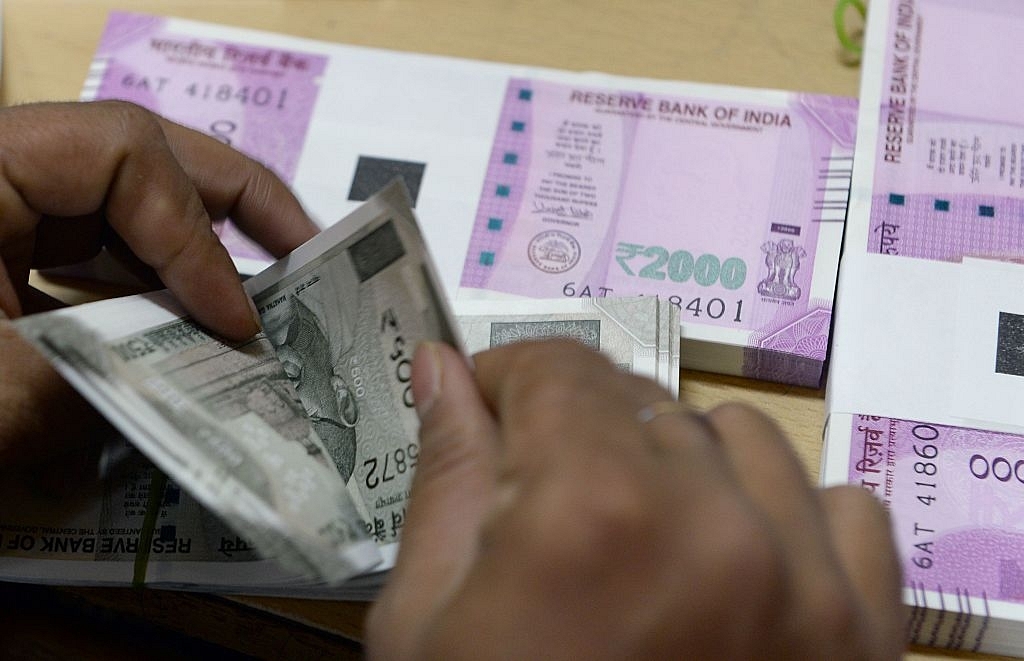Economy
As RBI Pumps In New Rs 200 Notes, It’s Time For DeMo-2 – Slow Withdrawal Of Rs 500 And Rs 2,000 Bills
- The case for DeMo-2 is strong, and it should be put into effect without fanfare as soon as enough Rs 100 and Rs 200 notes are printed.
- The Rs 2,000 and Rs 500 notes can then be withdrawn and squeezed out of the system without any disruption.

A bank staff member counts Indian 500 rupee notes to give to customers. (INDRANIL MUKHERJEE/AFP/Getty Images)
With the new Rs 200 currency note now in the process of being printed before release to the public, it is time to think about DeMo-2 – a non-disruptive and slow phasing out of higher-value notes printed in a hurry between November 2016 and now to replace the demonetised Rs 500 and Rs 1,000 notes.
For a start, we must assume that some of the short-term goals of demonetisation – a huge revenue bonanza from notes that didn’t return to the system, a large increase in tax revenues – have either not been realised or even been overwhelmed by the losses in national output and jobs. DeMo-2 is important to salvage some long-term gains which may include the prevention of fresh accumulation of black money in cash, and use of counterfeit and other currency for terrorist and other illegal operations.
Demonetisation (DeMo-1) was disruptive because in one fell swoop, 86 per cent of the currency in circulation (in value terms) was withdrawn, and the replacement took more than three months.
DeMo-2 will be totally non-disruptive, since the idea is to stop printing the new Rs 500 and Rs 2,000 notes, and withdraw them steadily whenever they return to the banking system. At some point in the future, when there are enough Rs 100 and Rs 200 notes to replace them with, one can even give holders a six-month window for exchange and full withdrawal. But this may not be needed at all.
DeMo-2 is important for three reasons:
One, large value notes are easier to store, and hence they will continue to be held as black money hoards. Replacing high-value notes with Rs 100 and Rs 200 notes whenever black money is generated will be tougher, for storage and movement becomes more cumbersome.
Two, counterfeiting and smuggling of fake notes becomes easier for India’s enemies like Pakistan when fewer notes must be carried in. Moving huge wads of smaller denomination notes across porous borders becomes tougher. According to the Reserve Bank of India’s last annual report, in 2015-16, 221,447 counterfeit notes were detected with a face value of Rs 100, 261,695 notes were in Rs 500 denominations, and 143,099 in Rs 1,000s.
But here’s the point: the value of counterfeits detected was disproportionately high in the higher-value notes: while only Rs 2.2 crore worth of Rs 100 notes were detected, the value of counterfeits in the Rs 500 and Rs 1,000 categories were Rs 13 crore and Rs 14.3 crore respectively. And, remember, these were only the notes detected; a lot more may have been sloshing around undetected.
Another worrisome thought: what if the DeMo rush to exchange old notes, a lot of counterfeits got exchanged for good money?
Three, even for local transactions, once the top currency values are reduced, it will be more convenient for citizens to pay by card or e-wallet than in Rs 100-Rs 200 notes. This will give a nudge to digital currencies and non-cash modes of payment, at least in high-value transactions.
The case for DeMo-2 is strong, and it should be put into effect without fanfare as soon as enough Rs 100 and Rs 200 notes are printed. The Rs 2,000 and Rs 500 notes can then be withdrawn and squeezed out of the system without any disruption.
DeMo-2 need not even be announced, for all it requires is for the government to put out larger quantities of smaller value notes whenever the larger denominations come in.
Support Swarajya's 50 Ground Reports Project & Sponsor A Story
Every general election Swarajya does a 50 ground reports project.
Aimed only at serious readers and those who appreciate the nuances of political undercurrents, the project provides a sense of India's electoral landscape. As you know, these reports are produced after considerable investment of travel, time and effort on the ground.
This time too we've kicked off the project in style and have covered over 30 constituencies already. If you're someone who appreciates such work and have enjoyed our coverage please consider sponsoring a ground report for just Rs 2999 to Rs 19,999 - it goes a long way in helping us produce more quality reportage.
You can also back this project by becoming a subscriber for as little as Rs 999 - so do click on this links and choose a plan that suits you and back us.
Click below to contribute.
Latest